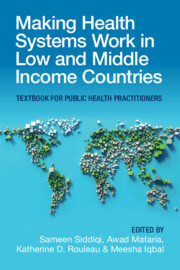 Making Health Systems Work in Low and Middle Income Countries
Making Health Systems Work in Low and Middle Income Countries from Section 2 - Transforming Health Systems: Confronting Challenges, Seizing Opportunities
Published online by Cambridge University Press: 08 December 2022
Private hospitals, clinics, and pharmacies, and the doctors, nurses, and other medical personnel who staff them provide a large portion of healthcare services in low- and middle-income countries (L&MICs). In some, the private sector delivers much more care than the government. Understanding the scale, capacity, quality, constraints and motivations of private providers and private facilities – whether for-profit, non-profit, formal or informal – is critical to assuring that health services and medicines support and expand the goals of access to quality health care for all. This chapter sets out what is known regarding private care provision, from world-class hospitals to unlicensed and untrained village drug-sellers and summarizes the experience and frameworks being applied around the world to measure, regulate, and assure the efficient and effective provision of private health care as part of mixed-health-systems in L&MICs. In many settings the challenges of private sector governance are complicated by limited data, minimal financial transfers, and weak regulatory systems. Despite this, advances have been made in L&MICs to defining and applying good governance strategies.
To save this book to your Kindle, first ensure [email protected] is added to your Approved Personal Document E-mail List under your Personal Document Settings on the Manage Your Content and Devices page of your Amazon account. Then enter the ‘name’ part of your Kindle email address below. Find out more about saving to your Kindle.
Note you can select to save to either the @free.kindle.com or @kindle.com variations. ‘@free.kindle.com’ emails are free but can only be saved to your device when it is connected to wi-fi. ‘@kindle.com’ emails can be delivered even when you are not connected to wi-fi, but note that service fees apply.
Find out more about the Kindle Personal Document Service.
To save content items to your account, please confirm that you agree to abide by our usage policies. If this is the first time you use this feature, you will be asked to authorise Cambridge Core to connect with your account. Find out more about saving content to Dropbox.
To save content items to your account, please confirm that you agree to abide by our usage policies. If this is the first time you use this feature, you will be asked to authorise Cambridge Core to connect with your account. Find out more about saving content to Google Drive.